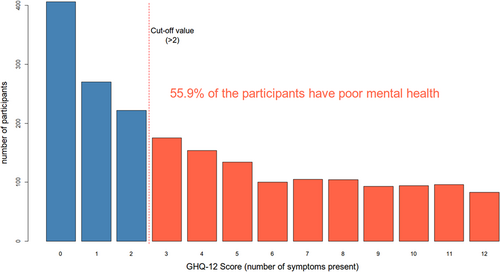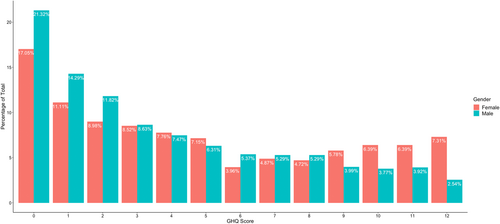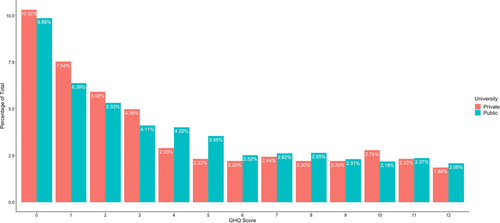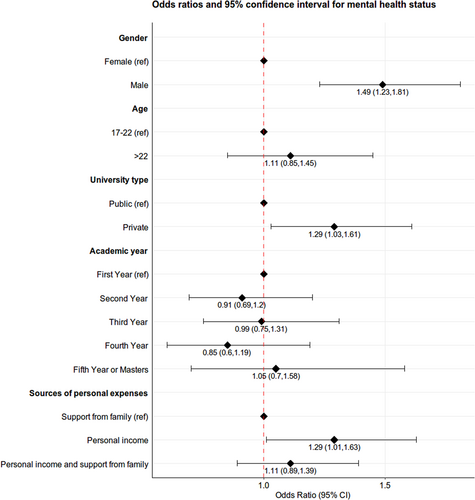Assessment of mental wellbeing of university students in Bangladesh using Goldberg's GHQ-12: A cross-sectional study
Musaddiqur R. Ovi and Md A. B.Siddique contributed equally, and the names were placed in alphabetical order.
Abstract
Background and Aims
The mental well-being of university students is a primary public health concern worldwide, including in Bangladesh. The objective of this study was to determine the prevalence of the overall mental health status among Bangladeshi university students. The study used larger and more diverse sample compared to previous studies, and also explored factors associated with the mental health well-being of those students.
Methods
Data were collected through an online questionnaire, utilizing the proportional allocation method, from students in various universities across Bangladesh. The sample included 2036 participants. The study applied Goldberg's General Health Questionnaire (GHQ-12) using the GHQ2+ threshold (i.e., having more than two symptoms). A binary outcome variable was created with two levels: “good mental health” and “poor mental health,” to assess the mental health status of the university students. The explanatory variables were age, gender, academic year, type of university, and sources of personal expenses. Exploratory data analysis, association tests, and binary logistic regression models were used to identify factors influencing the outcome variable.
Results
A total of 55.9% of students (male: 52.6% and female: 62.8%) exhibited poor mental health status. Female students' mental health was found to be worse (odds ratio [OR]: 1.49, 95% confidence interval [CI]: 1.23–1.81) compared to that of males. Similarly, public university students displayed a worse mental health condition than their counterparts in private universities (OR: 1.29, 95% CI: 1.03–1.61).
Conclusion
The overall mental health of university students in Bangladesh is concerning. There is a pressing need for effective mental health policies and interventions to bolster the mental well-being of university students, with a specific focus on students from public universities and females.
1 INTRODUCTION
One in every four young people experiences mental illness yearly,1, 2 with 75% of such illnesses starting before age 24 years.3, 4 Furthermore, one-third of university students have diagnosable mental disorders.5 Attending university is a transitional period that can bring unexpected difficulties.6, 7 Students face challenges and must make independent decisions regarding their lives and studies.8 Although these challenges can prepare them for future careers,9-12 they can also lead to extreme stress, anxiety, and even suicidal tendencies.12 As a result, students may become susceptible to physical and mental health issues without even realizing it.12-16 Environmental factors, such as campus life, unhealthy behaviors, and academic pressures, can affect their mental health.11 Being separated from family, experiencing peer competition, and living alone in dormitories can also intensify stress levels.17, 18 Their mental health affects academic performance,19, 20 leading to significant dropout rates in some regions.5 Hence, the well-being of these students has emerged as a global public health concern.21
In South Asian countries, the prevalence of mental health problems among university students is very high (depression 29.4%, anxiety 42.4%, and stress 16.4%).22 Bangladesh is hardly an exception, with estimates of the prevalence of mental health issues in the population reaching 16.1% for adults and 5.2% for children and adolescents aged 5–15 years.23 In the past, numerous mental health-related incidents, such as attempted suicides and suicides, have been reported among students in Bangladeshi universities. According to reports, five university students committed suicide over a span of 10 days, while 13 medical students took their own lives in 23 months.24 Furthermore, 56 Bangladeshi students committed suicide between January 2018 and June 2019. These tragic incidents occurred across various tertiary educational institutions, encompassing public and private universities throughout Bangladesh. Consequently, the mental health of Bangladeshi university students has emerged as a grave concern.25
Previous research has linked mental health in university students with factors like gender, age, academic year, university type, and sources of personal expenses.26-28 Studies in Bangladesh, Egypt, and Sri Lanka showed that female students are more prone to depression,26-28 whereas older students experience more mental health symptoms.29 It also rises with the academic year.26, 27 Moreover, financial obstacles affect middle-class students, impacting their mental health.4, 30 Comparatively, private university students exhibit better mental health.31 Considering these findings, the study included these variables to better understand their impact on mental health among university students.
Although several studies have assessed the mental health of Bangladeshi university students, most of these studies were conducted among students from private universities in Dhaka.11 Although several studies have been conducted in public institutions, they primarily focused on undergraduate or fresher students, largely overlooking postgraduates.32, 33 For instance, Hasan et al.34 examined depression, sleeping patterns, and suicidal thoughts among medical students in Bangladesh. Similarly, Koly et al.26 evaluated depression prevalence among Bangladeshi students at public universities, but their samples were drawn from only two such institutions. Consequently, these studies may not have provided a comprehensive view of the mental health landscape for university students across the country. There have not been studies in Bangladesh that holistically evaluate the mental well-being of postgraduate and undergraduate university students on a national scale. Additionally, these studies often had smaller sample sizes. Furthermore, maintaining a sufficiently large sample size was crucial for robust statistical power and precise analysis. Therefore, the primary objective of this study is to evaluate the overall mental health status of Bangladeshi university students and identify factors influencing their mental well-being, using a significantly larger and more diverse sample than previous studies.
2 METHODOLOGY
2.1 Study population and data source
A cross-sectional study was carried out involving 2036 participants, comprising 657 female and 1357 male students from 83 public and private universities across Bangladesh (Supporting Information S1: Table S1) between February and April 2021. There are 155 universities in Bangladesh in total; 52 of them are public and 103 are private.35 We reached out to students at every university in Bangladesh to request them to complete the questionnaire to ensure that our sample is representative of the overall population. Upon obtaining our estimated sample size of 2036, we found that the samples encompassed 83 universities (of which 45 were private and 38 were public), accounting for over half of Bangladesh's total university and ensuring representativeness. Next, based on the proportionate allocation method, students were chosen from the schools. The data were compiled from students across five different schools: physical science, applied science, life science, business administration, and fine arts. The selection of the five schools for the study was grounded in the educational landscape of universities in Bangladesh. Most universities in Bangladesh typically organize their academic departments into these specific disciplines, reflecting the primary areas of study available to students. Given this prevalent structure, these five schools effectively represent the country's diverse academic pursuits of university students. Thus, the decision to focus on these schools was practical and representative, as students in Bangladesh predominantly enroll in programs affiliated with one of these disciplines.4 During the data collection period, the Bangladeshi government imposed a complete lockdown due to the COVID-19 outbreak and all educational institutions in the country were closed. Consequently, in lieu of in-person interviews, the study conducted an online questionnaire survey for its feasibility, convenience, and affordability.36 This questionnaire gathered socio-demographic information from the respondents and included the 12-item variant of Goldberg's General Health Questionnaire (GHQ-12).
2.2 Sample size
S = sample size
Z = Z-score
P = population proportion (assumed 0.5 since population proportion was unknown)
d = margin of error (0.02).
Moreover, every possible effort was made to reach out to students in Bangladeshi universities, requesting them to complete the questionnaire. This was to make sure that the study's sample accurately represents the total population. From the collected responses, the study gathered samples from 2036 students across 83 universities (of which 38 were public and 45 were private). This ensures representativeness since it covers about two-thirds of Bangladesh's total number of universities.
2.3 Instruments
The study used GHQ-12, a self-administered evaluation tool designed for mental health screening to detect people who have a diagnosable mental illness.37, 38 It is a well-known test for evaluating minor mental stress and has been made accessible in several different languages. The initial edition of the questionnaire had 60 items (GHQ-60). However, it was reduced later to shorter variants such as 28 items (GHQ-28) and the shortest 12 items (GHQ-12) version.38 Researchers have proven GHQ-12 to be both valid and reliable for usage in adults in many different nations and South Asian countries such as in Indonesia.39 Moreover, it was also used by World Health Organization.37, 40 Bangladesh was also one of many developed and low-middle income nations where GHQ-12 was widely used and validated.41, 42 It has been validated against Clinical Interview Schedule, demonstrating its sensitivity (85%) and specificity (79%).43 For instance, a study conducted by Goldberg and Williams44 found a high reliability score and a strong internal consistency for GHQ-12, as shown by its Cronbach's α of 0.87. Furthermore, the GHQ-12 had also been very reliable in previous studies, with Cronbach's α values ranging from 0.80 to 0.94.39, 44 In addition, the sensitivity and the specificity for GHQ-12 were found 81% and 62%, respectively.39 This brief screening instrument has been used frequently all over the world to evaluate the mental health status of university students.40, 45-48 Thus, the instrument is relevant for the study because of its clear and brief form and validity in the setting of Bangladesh.
Each item uses a four-point Likert scale to assess the severity of a psychological condition in the previous few weeks. The study used the more appropriate binary GHQ scoring (0–0–1–1) method, which yields a possible total score range of 0–12. Higher GHQ-12 ratings suggest more general psychological distress and depression. For case detection the study used GHQ score 2 (GHQ2+) as cutoff value, which indicates that an individual must show more than 2 symptoms to be diagnosed with a mental health condition. This cutoff value was found to be the best threshold value for GHQ scoring in a worldwide study with highest sensitivity (83.5%) and specificity (75.1%).37 Reliability analysis of the questionnaire based on the sample was performed using Cronbach's α (Supporting Information S1: Table S2).
2.4 Outcome variable
The binary outcome variable was created using GHQ-12 and was used to examine the mental health status of university students on two levels: “good mental health” and “bad mental health.” The GHQ2+ threshold (i.e., having more than two symptoms) was used to assess university students' mental health. It was computed using the overall score of the screening tool, the GHQ-12. GHQ score > 2 falls into the bad mental health category as they had greater than two symptoms.
2.5 Explanatory variables
The socio-demographic variables, such as age, gender, sources of personal expenses, university type, and academic year were included as explanatory variables in this study. Age of the participants were categorized into two groups such as 17–22 years and 23 years old or above. Two general categories were used for university type: private and public universities. Respondents' sources of personal expenses were classified into three categories: support from family, personal income and both sources.
2.6 Statistical analysis
The score distributions for each item of the GHQ-12 were calculated to gain a better understanding of students' mental health. Subsequently, a reliability analysis of the entire scale was conducted to determine the instrument's internal consistency using Cronbach's α. A binary outcome variable was derived from the total scores of the GHQ-12 using a recommended cutoff value. Descriptive statistical analyses were conducted for both the socio-demographic characteristics of the participants and the outcome variable. The χ2 test was utilized to determine the association between the explanatory variables and the outcome variable. Binary logistic regression was then employed to ascertain the influence of the explanatory variables on the response variable. To provide evidence of the invariance of the measurement models, this study performed stratified analyses based on university types and gender (Supporting Information S1: Tables S3 and S4). SPSS Version 25 and RStudio (2019) were used for the analysis of the data.
2.7 Ethics approval and consent to participate
In line with international ethical standards, all respondents provided signed consent forms. Participants were informed about the objective of the study and were assured of the confidentiality of their data. The study adhered to the ethical guidance stipulated in the 1964 Helsinki Declaration and its later revisions. The ethical review committee of the Biostatistics, Epidemiology, and Public Health Research group in the Department of Statistics, Shahjalal University of Science and Technology, Sylhet, Bangladesh, granted approval for the study. Furthermore, participants were made aware that their participation was entirely voluntary and that they could withdraw at any point. Any concerns raised by the respondents regarding the survey were acknowledged.
3 RESULTS
Table 1 reveals that the study included 2036 participants from Bangladeshi universities, comprising 1379 males and 657 females. Students from all undergraduate and postgraduate academic years were represented: 20.0% from the first year, 22.8% from the second, 22.3% from the third, 22.9% from the fourth, and 11.9% from the fifth year or master's programs. A significant proportion of students (61.6%) managed their personal expenses with support from their families. In contrast, 17.7% of students handled expenses through their own income and the remaining 20.6% utilized a combination of both personal income and family support. The majority (78.8%) of the participating students were from public universities, whereas 21.2% attended private institutions. In terms of age distribution, 62.8% of the students were under 22 years old, with the remaining 37.2% being 22 years or older.
| Demographics | Number of participants (n) | Percentage of participants (%) |
|---|---|---|
| Gender | ||
| Female | 657 | 32.3 |
| Male | 1379 | 67.7 |
| Academic year | ||
| First year | 408 | 20.0 |
| Second year | 464 | 22.8 |
| Third year | 454 | 22.3 |
| Fourth year | 467 | 22.9 |
| Fifth year or masters | 243 | 11.9 |
| Sources of expenses | ||
| Personal income | 361 | 17.7 |
| Support from family | 1255 | 61.6 |
| Personal income and support from family | 420 | 20.6 |
| Type of university | ||
| Public | 1605 | 78.8 |
| Private | 431 | 21.2 |
| Age (years) | ||
| 17–22 | 1279 | 62.8 |
| >22 | 757 | 37.2 |
| Heard about World Mental Health Day | ||
| Yes | 1699 | 83.4 |
| No | 337 | 16.6 |
| Heard about World Sleep Day | ||
| Yes | 1043 | 51.2 |
| No | 993 | 48.8 |
| Heard about World Suicide Prevention Day | ||
| Yes | 1062 | 52.2 |
| No | 974 | 47.8 |
- Abbreviation: n, number of participants.
Table 2 displays that the first item had a mean score of 0.25 with a standard deviation (SD) of 0.43 and 75.0% of responses indicated “Symptom Absent.” Nearly 25% of the students perceived themselves as worthless. The subsequent three items presented a similar trend, with students feeling reasonably unhappy, indecisive, and unable to face problems (27.7%, 29.5%, and 29.7%, respectively). The 5th to 10th items recorded higher percentages (ranging from 31.7% to 38.5%) of “Symptom Present,” indicating that more than approximately one-third of the students experienced these symptoms. Notably, almost 45.0% of students reported difficulty concentrating on tasks and 54.5% felt constantly under strain.
| Items | Mean | SD | Response frequency (%) | |
|---|---|---|---|---|
| 0 (Symptom absent) | 1 (Symptom present) | |||
| 1. Thinking of self as worthless person | 0.25 | 0.43 | 75.0 | 25.0 |
| 2. Feeling reasonably happy | 0.28 | 0.45 | 72.3 | 27.7 |
| 3. Being capable of making decisions | 0.29 | 0.46 | 70.5 | 29.5 |
| 4. Able to face up to problems | 0.30 | 0.46 | 70.3 | 29.7 |
| 5. Losing confidence | 0.32 | 0.47 | 68.3 | 31.7 |
| 6. Not able to overcome difficulties | 0.32 | 0.47 | 68.1 | 31.9 |
| 7. Feeling unhappy and depressed | 0.33 | 0.47 | 66.8 | 33.2 |
| 8. Enjoying day-to-day activities | 0.36 | 0.48 | 64.2 | 35.8 |
| 9. Loss of sleep over worry | 0.36 | 0.48 | 63.8 | 36.2 |
| 10. Playing a useful part | 0.38 | 0.49 | 61.5 | 38.5 |
| 11. Being able to concentrate | 0.45 | 0.50 | 55.0 | 45.0 |
| 12. Feeling constantly under strain | 0.54 | 0.50 | 45.5 | 54.5 |
| Overall Mean GHQ-12 score | Mean: 4.19 | SD: 3.76 | IQR: 6 | |
- Abbreviations: GHQ, General Health Questionnaire; IQR, interquartile range.
Figure 1 and Supporting Information S1: Table S5 illustrate the overall frequency distribution of GHQ-12 score items within the sample. A score of zero had the highest prevalence at 19.9%. The following two scores accounted for 13.3% and 10.9%, respectively. The remaining scores, up to 12, ranged between 8.6% and 4.1%. Figures 2 and 3 depict the distribution of scores per GHQ-12 items, segmented by gender and university type, respectively.



Table 3 presents the overall mental health status segmented by demographic characteristics. Approximately 55.9% of the students displayed poor mental health conditions, with a breakdown of 413 females and 725 males. In a gender comparison, a higher percentage of female respondents (62.9%) had poor mental health than their male counterparts. Students from all academic years exhibited similar levels of poor mental health, with percentages ranging approximately from 51.9% to 57.3%. Furthermore, 56.9% of students aged 17–22 years exhibited poor mental health, whereas 54.2% of those aged above 22 reported similar conditions. When comparing institutional types, students from public universities (56.8%) reported a higher incidence of poor mental health than those from private universities (52.4%). Financially, almost half of the students (50.1%) managed their personal expenses independently, 57.9% relied on familial financial support, and 54.8% sourced their expenses from a combination of personal income and family contributions. Notably, these groups all indicated prevalent poor mental health conditions. A χ2 association test revealed significant associations between mental health status and factors such as gender and sources of personal expenses.
| Demographics | Mental health status | p | |
|---|---|---|---|
| Good mental health n (%) | Poor mental health n (%) | ||
| All participants (n = 2036) | 898 (44.1%) | 1138 (55.9%) | |
| Gender | <0.001 | ||
| Female | 244 (37.1%) | 413 (62.9%) | |
| Male | 654 (47.4%) | 725 (52.6%) | |
| Academic year | 0.69 | ||
| First year | 178 (43.6%) | 230 (56.4%) | |
| Second year | 198 (42.7%) | 266 (57.3%) | |
| Third year | 203 (44.7%) | 251 (55.3%) | |
| Fourth year | 202 (43.3%) | 265 (56.7%) | |
| Fifth year or masters | 117 (48.1%) | 126 (51.9%) | |
| Sources of expenses | 0.03 | ||
| Personal income | 180 (49.9%) | 181 (50.1%) | |
| Support from family | 528 (42.1%) | 727 (57.9%) | |
| Personal income and support from family | 190 (45.2%) | 230 (54.8%) | |
| Type of university | 0.10 | ||
| Public | 693 (43.2%) | 912 (56.8%) | |
| Private | 205 (47.6%) | 226 (52.4%) | |
| Age (years) | 0.23 | ||
| 17–22 | 551 (43.1%) | 728 (56.9%) | |
| >22 | 347 (45.8%) | 410 (54.2%) | |
- Abbreviation: n, number of participants.
Figure 4 and Supporting Information S1: Table S6 present results from the binary logistic regression analysis of the mental health status of university students, including odds ratios (OR) and a 95% confidence interval (CI). Gender had a significant association with mental health status. Male students were 1.49 times (95% CI: 1.23–1.81) more likely to belong to the good mental health group compared to female students. Students from private universities were 1.29 times (95% CI: 1.03–1.61) more likely to exhibit good mental health than students from public universities. Other explanatory variables, such as age, academic year, and sources of personal expenses, didn't significantly influence an individual's mental health status.

The GHQ-12 item-scale analysis can be found in Supporting Information S1: Table S2. For the entire sample, this study obtained a Cronbach's α value of 0.900, with a standardized α of 0.902.
Significant factors in the models are displayed in Table 4. Among all the variables, gender was consistently significant across models for all cut-off points. University type was significant for the 2+, 3+, and 4+ cutoff points.
| Variables in the model | GHQ-12 cutoff points (% of scores above cutoff) | ||||
|---|---|---|---|---|---|
| 1+(66.8) | 2+(55.9) | 3+(47.3) | 4+(39.7) | 5+(33.2) | |
| Gender | * | * | * | * | * |
| Age | |||||
| University type | * | * | * | ||
| Academic year | |||||
| Sources of personal expenses | |||||
- Abbreviation: GHQ, General Health Questionnaire.
4 DISCUSSION
The mental health of university students represents a significant and escalating public health concern worldwide.49 This study aimed to assess the overall mental health status of university students in Bangladesh using the GHQ 12-item questionnaire and to identify factors influencing their mental well-being. The study found that more than half of the participants had a poor mental health condition. Female participants' mental health condition was found to be significantly worse than that of male students. This finding is in line with other studies.50, 51 This could be because female students are more psychologically fragile than male students52 and are more likely to suffer from mental disorders than male students, according to both a Spanish and a Hong Kong study,53, 54 or it could be a combination of factors such as academic, socioeconomic, and cultural factors.52, 54, 55 However, in an Egyptian study, male students tended to be more depressed than female students, while female students had more anxiety than male students.56
When compared to students at private universities, public university students were shown to have poorer mental health. According to a recent study, they were more depressed than private university students.18 Typically, public universities in Bangladesh have a number of concerns with students, such as housing, which includes sharing a room with up to 100 or more other students.57 In addition, as public universities are less expensive than private universities, students from low or middle-income families are more likely to attend public universities in Bangladesh58 and the delay of graduation, followed by an ambiguous professional career and a widely expected financial collapse59, 60 might contribute to increased depression among Bangladeshi public university students.
Although, age was found significant in some other studies, 57, 61 the study failed to find a significant association between mental health and age. However, in the findings, students above the age of 22 years had a slightly better mental health (OR: 1.11) than students under the age of 22 years.57, 61 This is due to the fact that students studying in the fourth year or at the Master's level have better adjustments to their study and living environments.
Similarly, sources of personal expenses did not significantly affect the mental health condition of the participants in this study. However, some studies in several countries, including Bangladesh, suggest that the unexpected growth in mental health problems among university students might be associated with a lack of emotional and financial support from their families.18, 54, 56 As a result, financial stress might have a negative impact on their mental health. Among the participants, those who earned their personal expenses themselves had better mental health than those who were financially dependent on their family (OR: 1.29). This is consistent with previous studies.18, 54, 56
Furthermore, there was no significant impact of the academic year on the mental health condition of the participants. A Bangladeshi study also reported that there were no significant variations in the number of students with mental health disorders across undergraduate, graduate, and postgraduate levels.18
The study also assessed the reliability of the widely used 12-item General Health Questionnaire and found a Cronbach's α value of 0.902. This represents high reliability and internal consistency of the questionnaire in the data. The result is consistent with other studies conducted worldwide using the same questionnaire items.40, 62-64 The sensitivity and specificity of the questionnaire was also reported to be high in different studies worldwide.37 Based on the findings, this questionnaire can be used to assess the mental health of Bangladeshi students. It is the first study to deploy the GHQ-12 questionnaire among university students throughout Bangladesh.
5 STRENGTHS AND LIMITATIONS
The data collected for this study covered around two-third (83 universities) of total public and private universities all over Bangladesh. Compared with other related research conducted in Bangladesh that focused on tertiary-level students, the sample size of the study (2036) was also significantly higher.25, 36, 65 The gender composition of the participants (female: 32.3%, male: 67.7%) were almost similar to other studies performed recently on the Bangladeshi university students.25, 65 However, there were some limitations in the study as well. The study collected data through online questionnaire form rather than face-to-face interview. In addition, this was a cross-sectional study. Consequently, it was an associational study and hence causality cannot be inferred. Therefore, longitudinal study is required to resolve these issues. Moreover, students' dependency on self-report might be a source of information bias.
6 RECOMMENDATIONS
As in many lower-middle-income countries, the allocation of resources for mental health services in Bangladeshi institutions is minimal. Additionally, students are often uninformed about mental health issues and are hesitant to seek healthcare services due to fears of social stigma and stigmatization. Furthermore, the psychological morbidity of university students represents a significant and underestimated public health concern.12 Given the increasing prevalence, it is crucial to recognize and address the importance of students' mental well-being.
The findings from the current study reveal that university students in Bangladesh experience poor mental health. These results underscore the need for increased attention to the mental well-being of Bangladeshi university students and the implementation of intervention programs aimed at enhancing their mental health. To address this issue, it is strongly recommended that tailored mental health programs be devised and implemented to specifically cater to the distinct needs of female students and those enrolled in public universities, who exhibit a higher prevalence of mental health issues. At the same time, awareness campaigns within university settings can be crucial in destigmatizing mental health issues and motivating students to get help without worrying about being judged. Collaboration between mental health specialists and university administrations should be fostered to effectively include mental health programs in the larger university environment, including academic courses and extracurricular activities. Finally, creating a more supportive and health-conscious learning environment for Bangladeshi university students requires ongoing study and monitoring to modify interventions in response to changing needs and trends.
7 CONCLUSION
The prevalence of mental health issues among university students in Bangladesh is notably high, with over half showing poor mental health. Particularly, female students had more unfavorable mental health conditions than males. Disparities in mental health conditions between public and private university students were significant, with the former displaying worse conditions. Financial dependency also appeared to affect student mental health adversely. The GHQ-12 questionnaire proved to be a reliable tool for assessing the mental health of these students. These findings underscore the importance of shaping and evaluating targeted interventions to enhance student mental health in universities across Bangladesh.
AUTHOR CONTRIBUTIONS
Musaddiqur R. Ovi: Data curation, formal analysis, methodology, software, visualization, writing—original draft, writing—review and editing. Md A. B. Siddique: Data curation, formal analysis, methodology, software, visualization, writing—original draft, writing—review and editing. Tanvir Ahammed: Formal analysis, methodology, software, supervision, visualization, writing—original draft, writing—review and editing. Muhammad A. B. Chowdhury: Investigation, methodology, project administration, resources, supervision, validation, writing—review and editing. Md J. Uddin: Conceptualization, funding acquisition, investigation, methodology, project administration, supervision, validation, writing—review and editing.
ACKNOWLEDGMENTS
The authors thank all the students who participated in this study and SUST Research Centre as well as for providing fund in data collection. All authors have read and approved the final version of the manuscript. Md Jamal Uddin had full access to all of the data in this study and takes complete responsibility for the integrity of the data and the accuracy of the data analysis. The research was partially funded by SUST Research Centre in data collection and the funding do not have any influences on the data collection and overall study findings.
CONFLICT OF INTEREST STATEMENT
The authors declare no conflict of interest.
TRANSPARENCY STATEMENT
The lead author Md Jamal Uddin affirms that this manuscript is an honest, accurate, and transparent account of the study being reported; that no important aspects of the study have been omitted; and that any discrepancies from the study as planned (and, if relevant, registered) have been explained.
Open Research
DATA AVAILABILITY STATEMENT
The data set collected and analyzed in this current study are not publicly available to maintain participants' confidentiality but are available on reasonable request from the corresponding author.




